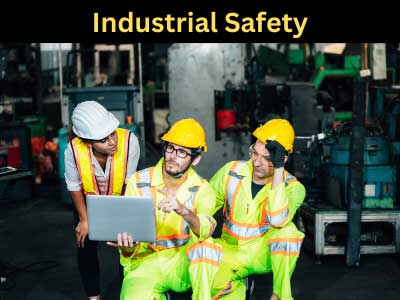Key Takeaway
The 4 Es of industrial safety are Education, Engineering Controls, Enforcement, and Engagement. Education involves training workers about safety practices and hazards. Engineering controls are physical changes to the workplace that reduce risks, like installing safety guards on machines.
Enforcement ensures compliance with safety regulations through inspections and penalties. Engagement involves actively involving employees in safety programs and encouraging them to report hazards and suggest improvements. Together, these elements create a comprehensive approach to maintaining a safe industrial environment, reducing accidents, and promoting a culture of safety.
Understanding the 4 Es: Engineering, Education, Enforcement, and Evaluation
The 4 Es of Industrial Safety—Engineering, Education, Enforcement, and Evaluation—are essential components for ensuring a safe and productive work environment. Each plays a unique role in mitigating risks and maintaining safety standards. Engineering focuses on designing systems and processes that minimize hazards, while Education ensures that employees are aware of safety protocols and trained to respond effectively to potential risks.
Enforcement ensures that these protocols are strictly followed, preventing unsafe practices from going unnoticed. Finally, Evaluation is key to continuously assessing safety measures, identifying areas for improvement, and updating protocols to reflect new challenges or regulations. Together, these four elements form a comprehensive approach to workplace safety, helping companies protect their workers and reduce incidents.

How Engineering Solutions Reduce Workplace Hazards
Engineering solutions are the foundation of industrial safety. By designing equipment and processes that prioritize safety, companies can significantly reduce workplace hazards. Engineering interventions include installing safety guards on machinery, improving ventilation systems to reduce exposure to harmful substances, and implementing automation technologies to limit the need for workers to perform dangerous tasks manually.
For example, machine safeguarding systems are designed to protect workers from injury while operating heavy equipment. Automated systems, such as robotic arms, can handle hazardous tasks like welding or material handling, keeping human workers out of harm’s way. In chemical industries, engineering solutions like fume hoods and proper ventilation prevent the inhalation of toxic fumes.
Moreover, ergonomic design reduces the risk of strain injuries by adjusting workstations to the physical capabilities of workers. Engineering plays a proactive role in eliminating risks before they can lead to accidents, making it one of the most critical components in industrial safety.
You May Like to Read
Importance of Employee Education in Industrial Safety
Education is a key factor in ensuring industrial safety. No matter how well-designed the equipment or protocols are, if employees aren’t aware of proper safety practices, accidents can still happen. Safety education involves training workers on how to use machinery safely, wear personal protective equipment (PPE), and follow emergency procedures in case of accidents.
Regular training sessions ensure that employees stay up-to-date on the latest safety protocols and know how to identify potential hazards in their work environment. In industries dealing with hazardous materials, employees must be educated on how to handle chemicals safely and how to react in case of a spill or exposure.
Employee education also fosters a safety-first mindset. When workers are empowered with knowledge, they are more likely to take personal responsibility for their safety and contribute to a culture of safety across the organization. By understanding the risks and how to mitigate them, workers help minimize accidents and injuries, ultimately creating a safer and more productive work environment.
The Role of Enforcement in Maintaining Safety Standards
Enforcement ensures that the safety measures set in place are consistently followed. Without proper enforcement, even the best-engineered systems and comprehensive training programs can fail. Supervisors and safety officers play a crucial role in monitoring workplace activities, ensuring that employees follow established safety procedures and use protective equipment.
In many industries, enforcement is tied to compliance with legal and regulatory standards. Regular audits and inspections are conducted to ensure that companies are adhering to safety regulations set by governmental bodies such as OSHA (Occupational Safety and Health Administration) or industry-specific regulations. Non-compliance can result in penalties, lawsuits, and even accidents that could have been easily prevented.
However, enforcement should not just be about punishment. It’s also about encouraging safe practices and rewarding teams or individuals who consistently follow safety protocols. When safety is enforced positively, it motivates workers to prioritize it, making enforcement a proactive measure that supports the overall safety culture.
Continuous Evaluation and Improvement of Safety Protocols
The final element, Evaluation, ensures that safety protocols are continuously reviewed and updated. Workplace environments evolve, and new risks emerge, so it’s essential that safety measures keep pace. Regular safety audits and feedback from employees help identify weaknesses or areas where improvements can be made.
For example, if an accident occurs, an investigation should be conducted to understand what went wrong and how future incidents can be prevented. This could lead to adjustments in safety protocols, new training programs, or updated engineering solutions. Similarly, if new machinery is introduced or production processes change, safety measures need to be re-evaluated and adapted to address any new risks.
Continuous evaluation ensures that companies are not only complying with current safety standards but also pushing toward better practices. Involving employees in the evaluation process can provide valuable insights, as they often experience safety issues firsthand. This proactive approach to improvement helps companies reduce workplace incidents and maintain a safer, more productive environment.
Conclusion
The 4 Es—Engineering, Education, Enforcement, and Evaluation—are fundamental to creating and maintaining a safe industrial environment. Each plays a vital role, from designing hazard-free workplaces to ensuring that safety protocols are understood, followed, and continuously improved. By focusing on these four elements, companies can reduce workplace accidents, ensure compliance with safety standards, and foster a culture of safety that benefits both employees and the business. Implementing the 4 Es effectively not only protects workers but also enhances productivity and operational efficiency, contributing to long-term success.
